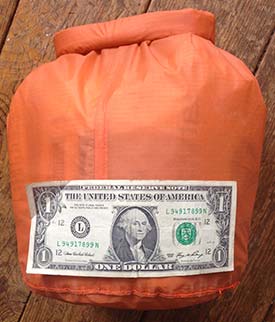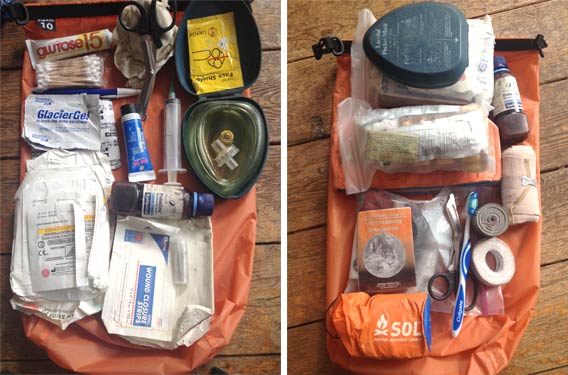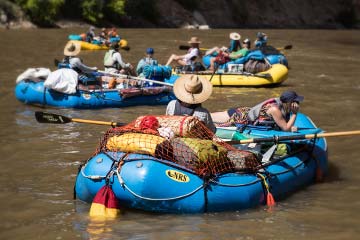First Aid on the Water
by Kyle “Smitty” Smith
Where is the second half of my crew? I’m wedged in the boiling eddy below a fierce, rock-jumbled rapid. Too much time has gone by. Something isn’t right. In the blink of an eye, I see a bright orange flash rounding the bend; it’s an empty kayak, followed by a paddle blade, then flotsam. I know what’s coming next. Kira is stumbling through the Lodgepole pines on river left, bleeding and confused. She looks like a boxer that just got her bell rung in the seventh round. Her eye is gaping at the brow, bleeding profusely—as head wounds do—down the side of her face. It’s nothing life threatening, but it’s nasty and a concussion is likely. We are miles from vehicle evacuation.
With a large number of paddlers ranging from Idaho to North Carolina to Argentina, nearly 20 boats slid into the Secesh . Opens a new window. that morning in the thicket of the Idaho wilderness. We split into two different groups to navigate a run that has been compared to an isolated North Fork Payette. We already had one person swim underneath a log and the pace was only going to pick up. Routing through one rapid after the other with little beta, Kira, as well as a number of other boaters, was left side surfing violently in random hydraulics. The edge of her kayak caught a rock, flipping aggressively, dumping Kira’s cranium into space preoccupied by Idaho batholith, some of the state’s oldest granite.
The next minute was a blur. Her boat tumbled on top of her while she recirculated in the hole for a few seconds, adding insult to injury. Tired from the violent throttling, swimming to shore amidst some of Idaho’s steepest class V was brutal. It’s a good thing that she is, as the kids say, a “B.A.” Luckily, there were a lot of hands on deck, some of which were barreling downstream without any eddies to catch amongst the chaos.
 In the pool below me, pieces were collected quickly and the intensity of the moment began to quiet. Recalling the Wilderness First Responder training from my Desert Mountain Medicine course, I rifled through my kayak for my comprehensive first aid kit. Like a swift slap to the face, I remembered leaving all of my heavy overnight bags in the car that would meet us at the confluence of the South Fork Salmon and the Secesh. To make paddling this steep class V a little easier, I left the unnecessary items such as sleeping bag, water filter, shelter, food… Damnit! In the back of the Subaru, miles away, in one of those bags was my comprehensive first aid medical kit. Of course today would be the one day that I forgot it. I kicked myself. Literally.
In the pool below me, pieces were collected quickly and the intensity of the moment began to quiet. Recalling the Wilderness First Responder training from my Desert Mountain Medicine course, I rifled through my kayak for my comprehensive first aid kit. Like a swift slap to the face, I remembered leaving all of my heavy overnight bags in the car that would meet us at the confluence of the South Fork Salmon and the Secesh. To make paddling this steep class V a little easier, I left the unnecessary items such as sleeping bag, water filter, shelter, food… Damnit! In the back of the Subaru, miles away, in one of those bags was my comprehensive first aid medical kit. Of course today would be the one day that I forgot it. I kicked myself. Literally.
Fortunately, statistics were in our favor. It was likely that at least one of the 20 paddlers on the water were not total shmucks. After asking around, I concluded that there were, indeed, 19 shmucks. The sole medical kit amongst all of us was sparse, but it had what we needed: Betadine, triple antibiotic ointment, a syringe, steri-strips and butterfly bandages.
I cringed with Kira while blasting her facial laceration with disinfectant from the irrigation syringe. I could practically see the skull… practically. My face hurts just thinking about her grimace every time I pressed the syringe down as hard as I could to remove all of the mucky river and bushwhacking debris out.
We closed the laceration with streri-strips and applied triple antibiotic to reduce the chance of infection. A bandage topped it off to prevent grime from getting into the wound during the inevitable hike out.
That day, we lucked out—one out of 20 people had a first aid kit. Kira got to definitive medical care after a six-mile hike to the Subaru. The doctor approved of the treatment and assured minimal scarring and low risk of infection due to the quick medical response.
When heading to the river, boaters of all disciplines check the obvious list: helmet, life jacket, dry suit, paddle/oars, throw-bag, etc. However, often times we don’t think about the next level. What happens when things don’t go as planned? What happens if I dislocate my elbow falling during a portage? What happens when the group loses a boat and at least one of us is subject to spending a night out in the elements? This is the next level checklist and one that needs to be completed if we, as boaters, are going to truly push our skills.
I have not left my med kit behind since that day on the Secesh. It’s a bit heavier than I would like and takes up more space than I would prefer during long overnight paddling missions, but I make it work. And when the situation arises, I am relieved to have it packed into the bottom of one of my float bags along with some basic medical training packed into the back of my brain.

Stop thinking about getting a medical kit and just do it! You and your paddling partners will be glad that you did. Even better, get signed up for a Wilderness First Responder class or at least a basic first aid course. If you don’t know what you want in the kit, you can always find a premade medical kit from companies such as Adventure Medical Kits (AMK). NRS contracts AMK to make a bomber water-specific kit. I always take a standard medical kit and tweak it with extra items that will style out most medical and emergency situations. Here is a list of what makes up my med kit:
1. Portable CPR Mask: A lot of kits come with cellophane-like “face shields.” They’re (barely) better than nothing. Get a real CPR mask. It’s fairly compact and fully protects you from bodily fluids that are common in a trauma event.
2. Adventure Medical C-Splint: It can be used for splinting any part of the body due to its moldable nature.
3. Write in the Rain Accident Report & Pencil: In a serious situation, someone should be taking vitals often. Grab a pencil and write them down. Now you can hand off your recordings to the EMS when they arrive.
4. Digital Thermometer that ranges from 90°F–105°F (preferably oral).
5. Trauma Shears: You need trauma shears to cut bandages, clothing, etc. These are blunt tipped to prevent injuring patients or punching through your dry bags. If you can only get a normal pair of scissors, use a wine cork to safety proof the points.
6. Irrigation Syringe: With lacerations or road-rash type abrasions, you have to make sure to clean the wound as deeply and thoroughly as possible. It’s going to hurt, but clean that wound like you mean it!
7. Povidone Iodine Solution (Betadine), basic disinfectant: Works much better than products like hydrogen peroxide.
8. Steri-Strips™ (wound closure strips): In times when stitches are needed but unavailable, these are a great substitute. They work like a charm and almost as well.
9. Tincture of Benzoin: Apply to skin to improve steri-strip and tape adhesion.
10. Triple Antibiotic Ointment: Don’t let the bacteria in after cleaning them out.
11. Antiseptic Towelettes
12. Moleskin: Great to have for long hike-ins and festering blisters.
13. Nitrile Examination Gloves: When the body fluids start exiting the victim’s body, you don’t want it entering yours.
14. Antimicrobial Hand Wipes: Handy for those times when soap and water cleanup isn’t practical.
15. Condoms: When combined with tape, they can be used to keep injured digits dry. Or use them as directed; it’s all about playing it safe, right?
16. Infectious Control Bag: The guy you found on the side of the road just bled all over your gloves and bandages. What do you do with the garbage? Have a bag to put it in.
17. Various assortment of Bandages:
- 4x4 Sterile Dressings
- 3x3 Sterile Dressings
- 2x2 Sterile Dressings
- Eye Pad
- Non-adherent Sterile Dressing
- 8x10 Trauma Pads
- 5x9 Trauma Pads
18. Small Tampons: A backcountry trick for severe bloody noses. Also comes in clutch when a fellow female boater can’t get to her stash.
19. Conforming Gauze Bandage (2" or 3")
20. Elastic Bandage w/ Velcro® (2" or 3")
21. Adhesive Tape 10 yards (1/2" or 1") also known as athletic tape
22. Strip Bandages
23. Knuckle Bandages
24. Triangular Bandage: Because dislocations are common paddling injuries. Be ready to sling an arm.
25. Cotton-tipped Applicators
26. Silvadene: It’s an amazing topical that is used for treating serious burns, if you can get your hands on it. Otherwise have Burn Aloe Gel (Sun and Wind)—I’ve needed this more than once.
27. Rehydration Salts (one liter): Emergen-C is a great alternative.
28. An assortment of Drugs:
- Ibuprofen (aka I.Be.Broken): A must have in the kit. Helps reduce inflammation and fever. When in Mexico, I try to get my hands on 800Mg Ibuprofen. This lightens up the first aid kit now that I carry one pill instead of four.
- Tylenol (Acetaminophen)
- Aspirin
- Hot Tip: Common pill packages will fall apart after time and you’ll find a busted piñata of pills and empty packaging in the bottom of the bag. Take a few small strips of duct tape and reinforce the packaging. Be sure to leave the medication’s name visible.
- Diphenhydramine (antihistamine): Bee Allergies anyone?
- Alamag® Antacid
- Diamode (Immodium®): For those rough international trips where nothing you put in your body wants to stay there for long.
- Phenergan / Promethazine (Anti Nausea Medication): Often, when you find yourself expelling waste from both ends, that means your body badly wants to get something out. This is great, but it also puts you at a high risk for severe dehydration. Anti-Nausea meds can help slow the loss of fluids.
- Glucose Paste (one serving): A quick fix for diabetics or blood sugar crashes.
- 1% Hydrocortisone (topical inflammation cream): For the moment when this escapes from a friend’s mouth: “I just grabbed a whole bunch of leaves that looked good to wipe with, Man! I didn’t know this was gonna happen!” (A true quote from Nepal.)
- After Bite®: Itch relief from bug bites.
29. Safety Pins
30. Survival gear, which should include:
- Waterproof Matches w/striking sheet
- SOL (Survive Outdoors Longer) Bivvy: Small sleeping bag just incase you find yourself hiking out of a deeply committing creek when night falls.
- Duct Tape: Gorilla Tape is best and can be used for everything.
- Bic Lighter (2)
- Collapsible water container & Katadyn water purification tablets: I once hiked out of a steep creek and ran out of water within the first half hour. The foliage was so thick, it took me six hours to get out. I drank from a muddy puddle due to dehydration. Tablets and a container would have saved me a huge hassle.
- A piece of bicycle tube: When in wet, dismal conditions, a piece of rubber tubing works incredibly well to start a fire. It’s not the most eco-friendly practice, but when it comes to surviving the elements, I’ll fight with my moral demons after I have avoided hypothermia. It can also be used to patch blown gaskets in a pinch.
- Aquaseal (small tube): Can be used for anything. This is worth more than gold in many situations.
31. Small Headlamp: Get a dependable lightweight headlamp for when night falls and you’re still trapped amongst the blackberry thickets.
32. Spare Toothbrush: I can’t tell you how many time I or friends have forgotten toothbrushes on overnighters.
Warning: Check with your physician to make sure that this first aid kit is right for you.

Take a Wilderness First Responder course to insure that you understand the basics of using your medical kit. Desert Mountain Medicine . Opens a new window. puts on a good one.
 NRS Gift Card: Always Fits, Always Wanted
NRS Gift Card: Always Fits, Always Wanted




